PRINCETON, NJ -- Gallup's Job Creation Index once again matched its high for the year last week, suggesting that the deterioration in the job market continues to ease, while Gallup's Consumer Confidence Index remained essentially unchanged from the prior week. Still, consumer spending fell back to its "new normal" level and is running 33% below the same week a year ago.
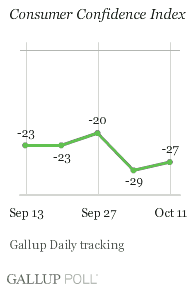
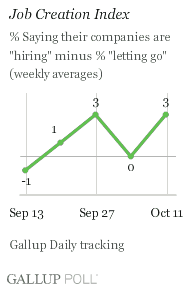
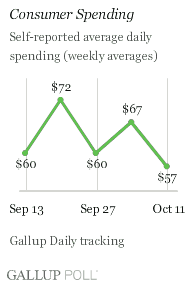
What Happened (Week Ending Oct. 11)
-
Job Creation bounced up last week, as Gallup's Job Creation Index improved to +3 -- up from zero the prior week and matching the 2009 high. The percentage of employees saying their companies are hiring also matched its 2009 high at 27% -- up from 22% a month ago and about the same as the 28% of a year ago. The percentage of workers saying their companies are letting people go, at 24%, was about the same as a month ago and a little worse than a year ago. At this point, the Job Creation Index suggests the job market has improved from earlier this year but remains somewhat worse than it was at this time last year, when the financial crisis was unfolding.
-
Consumer Confidence was essentially flat last week, as Gallup's Consumer Confidence Index was at -27, compared to -29 the prior week. The percentages of Americans saying the economy is "getting better" (38%) or saying it is "getting worse" (56%) were not much different than the prior week. Consumer confidence was a little less positive last week than it was a month ago, though still much better than it was during last year's financial crisis.
-
Consumer Spending reflected its 2009 "new normal," as self-reported daily spending in stores, restaurants, gas stations, and online averaged $57 -- down from the previous week's $67-per-day spending level, but essentially the same as spending a month ago. While spending has been bouncing within a $15 range during recent weeks, it continues to be down 30% or more compared to last year, even though last year's comparables reflect the onset of the financial crisis that began to unfold last September.
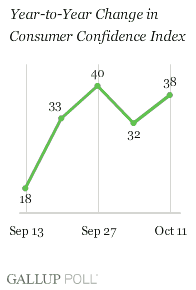
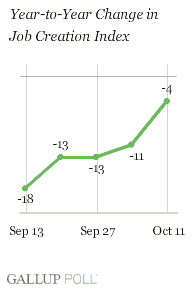

What to Watch For
Consumer spending continues to disappoint. Gallup's Consumer Spending measure has been essentially flat in 2009 -- and remains substantially below the financial crisis-depressed spending levels of a year ago. This continues even though consumer confidence is much improved from earlier this year -- let alone last year -- and as the job market appears to be stabilizing compared to earlier in 2009. Not surprisingly, these trends and the end of the "Cash-for-clunkers" program indicate a weak September retail sales report on Wednesday.
Thursday's jobless claims are likely to be distorted by the Columbus Day holiday, but Gallup's Job Creation Index suggests they will show a modest improvement over the 521,000 reported last week. Still, Gallup's modeling suggests the October unemployment rate is likely to hit 9.9% when reported next month. Even though job-market conditions are moderating in Gallup's most recent surveying, the overall job situation on Main Street continues to worsen.
On Friday, the Reuters/University of Michigan Consumer Sentiment Index is likely to show a modest decline, given Gallup's findings in its monitoring of consumer confidence. However, the lessening of confidence Gallup recorded during the first two weeks of October is small and may not be accurately picked up because of the limited sample size of the consumer sentiment measurement survey.
Of course, for many retailers and small businesses, holiday sales may determine whether they feel any real Christmas joy this year. Gallup's first look at consumers' Christmas spending intentions suggests intentions are down about 8% from a year ago. This seems consistent with the 2009 new normal for spending and today's nearly double-digit unemployment rate. In turn, this suggests that the National Retail Federation's forecast of a 1% decline in holiday sales may be somewhat optimistic.
Still, Christmas spending intentions -- like weekly consumer spending trends -- are worth watching closely over the next several weeks. Last year, Christmas spending intentions fell sharply in November and December as the financial crisis deepened and the unemployment situation worsened. Perhaps if the job market continues to improve and the stock market continues to go higher, a similar decline in spending intentions as well as in actual holiday spending will be avoided this year.
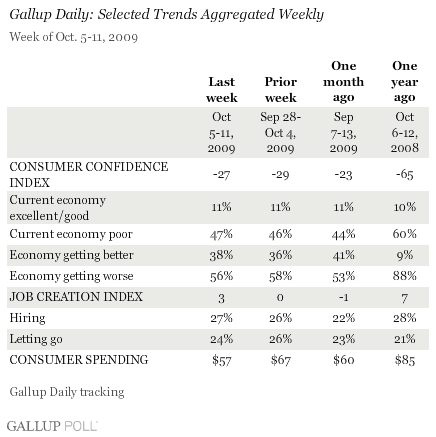
Review and export the complete daily trends on these measures: Economic Indexes; Consumer Spending; Economic Outlook; Economic Conditions; Job Market
Learn more about Gallup's economic measures.
Get Gallup news on Facebook and Twitter
Survey Methods
For Gallup Daily tracking, Gallup interviews approximately 1,000 national adults, aged 18 and older, each day. The Gallup consumer perceptions of the economy and consumer spending results are based on random half-samples of approximately 500 national adults, aged 18 and older, each day. The Gallup job creation and job loss results are based on a random half sample of approximately 250 current full- and part-time employees each day. Results from the week of Oct. 5-11, 2009, are based on telephone interviews with 3,516 adults for the consumer perceptions and spending questions. For these results, one can say with 95% confidence that the maximum margin of sampling error is ±2 percentage points. Results for the job creation and job loss questions are based on interviews with 1,942 employees, with a maximum margin of error of ±3 percentage points.
Interviews are conducted with respondents on land-line telephones (for respondents with a land-line telephone) and cellular phones (for respondents who are cell-phone only).
In addition to sampling error, question wording and practical difficulties in conducting surveys can introduce error or bias into the findings of public opinion polls.
